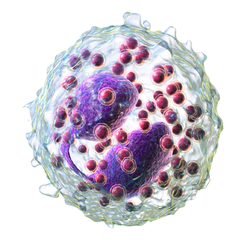Eosinophil granulocyte
Eosinophil granulocytes, usually called eosinophils or eosinophiles, are granulocyte white blood cells that fight off certain parasites and infections in vertebrates. When they are activated, eosinophils release a cocktail of proteins from their granules, including heparin. Like mast cells and basophils, their main targets are parasites, and they are part causes of the syndromes called asthma and allergy.
| Eosinophil | |
|---|---|
 3D rendering of eosinophil | |
 Eosinophil under the microscope (400x) from a peripheral blood smear. Red blood cells surround the eosinophil, two platelets at the top left corner. | |
| Details | |
| Pronunciation | /ˌiːoʊˈsɪnəfɪl/)[1] |
| System | Immune system |
| Identifiers | |
| MeSH | D004804 |
| TH | H2.00.04.1.02017 |
| FMA | 62861 |
| Anatomical terms of microanatomy | |
Eosinophils make up 1-6% of white blood cells circulating in the body. They are similar in size to neutrophils but have reddish-orange granules (when stained with eosin) and a bilobed nucleus. Eosinophil granulocytes are important defenders against large, multi-cellular parasites, such as worms and flukes. Their numbers increase during a parasitic infection.
References
change- ↑ "eosinophil - Definition of eosinophil in English by Oxford Dictionaries". Oxford Dictionaries - English. Archived from the original on 14 June 2018. Retrieved 27 March 2018.